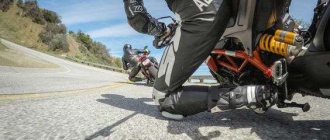Have you ever encountered a situation where you need to flare a tubeless tire on the road and at the same time inflate the wheel a little and you need to do all this without a pump, since a regular car pump and an electrode pump on a tubeless tire are pointless. The air will simply escape along the edges of the tubeless, since the tire does not sit tightly on the rim. You can place it on the disk only with high pressure or a very fast pumping speed - such as compressors at a service station. But not a common automobile compressor, and certainly not a hand pump.
Well, actually, the situation, for some reason, a situation arose on the road when it was necessary to carry out this very operation of beading a tubeless tire - the spare wheel came off, the tire was deflated, the spare wheel was beaded from a damaged one to a whole one, etc. How to do this, so to speak, in the field.
How to inflate a tubeless tire yourself. Several ways to inflate a tubeless tire
After mounting a tubeless tire on a wheel rim, it is not so easy to inflate it. Tire shops and service stations do not count. We are interested in how to inflate a tubeless tire yourself.
Why is everything so difficult
The problem is that usually after mounting the wheel between the tire and the rim of the disc there is a gap of 5 millimeters to 5 centimeters or, as professionals say, the tire “does not sit in place.”
There is simply no point in inflating such a tire with a foot pump, or even more so with a hand pump - all the air pumped by the pump will exit through the above-mentioned gap. At tire service centers, this issue is solved simply: using pneumatic shock devices, powerful compressors, boosters or inflators, a large amount of air is supplied into the gap between the rim and the tire in a short period of time. After the tire “slams shut” and sits in its mounting location, air is pumped in the usual way - through the tire nipple using a standard hose with a pressure gauge.
What to do if there is simply no equipment for pneumatic impact? Over the years of operation, motorists have invented several ways to inflate tubeless tires. From safe to risky, from labor-intensive to effortless. Which method is more acceptable is up to you to choose.
We use flammable liquids
Place the fully assembled and mounted wheel on the ground. The spool from the nipple must be unscrewed. Apply a small (10 to 20 ml) amount of gasoline, WD-40 liquid or carburetor cleaner in a circle into the gap between the tire and the rim of the wheel.
Next, you need to safely (using a torch from a newspaper or throwing a match from afar) ignite the vapors of flammable liquid formed inside the tire, which, when ignited, will increase the volume of air and after a noticeable bang the tire will sit tightly in its seat.
It is possible that the wheel can jump up to half a meter above the ground. Therefore, be prepared for such effects and use caution.
We screw the valve into the nipple and inflate the tire in the usual way using a pump.
We resort to using an inflated wheel
We inflate the spare tire or wheel on the car with a pump to a pressure of about 4 atmospheres. We remove the hose from the pump and put the side that was removed from the pump tube onto the nipple of the tubeless tire that needs to be inflated. We remind you: the spool must be unscrewed from the tire.
We put the second end of the hose with a lock onto the fitting of the tire with excess pressure and fix it. Air from the “inflated” tire will flow under pressure through the hose into the empty tire and it will “sit back into place” quite quickly. All that remains is to disconnect the hose first from the donor wheel, and then from the recipient tire, screw the spool into the nipple and inflate both wheels to the required pressure.
We use a rope
If you wrap a piece of sling or rope around the tire in a circle, along the line. Further
Source
Extreme mountain bike
Drivers know that it will not be possible to inflate a tubeless tire with a conventional pump after installing it on the rim - the air will simply come out of the gap between the rim and the tire rim.
In order for the tire to “sit” tightly in its place on the rim, you need to supply a large portion of air in a short time, for example from a compressor receiver, as is done at a service station. But not everyone has such compressors in their garage, so how can you get out of the situation and pump up the “tubeless”, using what is called “improvised means”? It's actually not that difficult to do.
To do this you will need some gasoline, carburetor cleaner, WD-40, or any other flammable liquid. Place the fully assembled wheel on the ground and spray a very small amount of flammable liquid in a circle into the gap between the tire and the rim. Do not pour too much gasoline, about 10 grams is enough. After this, quickly ignite the resulting flammable liquid vapors in the tire (just throw a lit match into the area of the gap between the tire and the rim).
There will be a popping sound and the tire will snap into place tightly. Now the tire can be inflated with a conventional pump to the required pressure.
If this method seems too extreme to you (after all, you need to be careful with fire and gasoline so as not to burn the entire car), you can use another method. Inflate any car wheel or spare tire to a pressure of about 4 atm. Remove the hose from the pump and connect its free end (the one without the fitting) to the nipple of the tubeless tire that needs to be inflated (the spool from the nipple must be removed). Now connect the other end of the hose, on which the fitting is located, to the “inflated” wheel. As a result, the air from the inflated wheel will very quickly be distributed into the tubeless tire, and it will fall into place on the rim. Now you can remove the hose, screw the spool valve into the tubeless nipple, and pump it up in the usual way to the required pressure.
Any motorist will confirm that it is very problematic to inflate an empty tubeless tire on your own, unless you have a high-pressure compressor in the garage, which is used in tire shops and service stations. In order for the tire to fit tightly to the rim of the disk without a gap, you need to supply a large amount of air into it in a short period of time, which is impossible to do with a conventional pump. What to do in a situation where there is no service station nearby and the tire is empty?
There are several ways to inflate a tubeless tire using available tools. The main task is to install the tire at the mounting location. When it closes tightly, it can be inflated using a conventional pump.
How to inflate a tubeless tube yourself on the track if the rubber does not fit tightly to the disc and the air escapes?
This can be done if you have a more or less efficient compressor, since pumping it up with a pump, and even if it’s done manually, is unlikely to work.
We seat one side of the tire on the disk very tightly; for this you can use soap or any fatty food (lard, butter, cream).
You need to coat the beads and, by turning and straightening, adjust the tire beads on the rim as much as possible.
Next, place the wheel up on the side that does not sit down.
The next step is to take 20-25 grams of gasoline and pour it inside the tire, this can be done either through the place where the air is being released or directly through the nipple using improvised means (a syringe, a funnel, a plastic bottle with a hole, even a piece of cellophane).
We spin the wheel in our hands and shake it so that the gasoline is distributed as much as possible throughout the inner space of the tire and evaporates as much as possible.
We wait a minute, connect the compressor, it should work and pump air, even if it does not create pressure at all, gasoline vapors will begin to come out at the point where the air comes out - then with a cold mind and without fear, light a match and throw it in that place, a pop occurs, but there is nothing to be afraid of 20 grams of gasoline is not the critical mass that can kill you with an explosion!
The wheel will jump and fall into place, and the compressor will begin to pressurize it from the inside, if suddenly somewhere on the wheel you see burning spikes or gasoline residues (to prevent this from happening, you need to wait a minute for the gasoline to evaporate!), then just knock out the fire with a rag and All.
These are the procedures, if you do it once, then the next time you will be confident in teaching other drivers.
I talked about the wheel of a passenger car, I don’t give advice , the volumes there are completely different and the risk of injury is greater.
Source
Flammable liquids
The wheel must be placed on the ground and the spool must be twisted off it. Inject a small amount of flammable liquid (5-10 ml) into the gap between the disk and the tire and set it on fire. The vapors will ignite and create pressure in the air, which will help the tire get into place. Then it can be easily pumped up with a conventional pump, having first screwed in the spool.
Gasoline, carburetor cleaner, WD-40 and other flammable liquids can be used as fuel. The main thing is not to overdo it with the quantity and have time to move to a safe distance, since the clap can cause the wheel to bounce above the ground.
How to inflate a car tire with a compressor?
The problem of depressurization of pneumatic tires has not yet been solved. Therefore, the question of how to inflate a car wheel with a compressor remains relevant. It's always annoying to find your car with a flat tire. We have to hurry on business, and then there’s this misfortune. Regular use of an electric pump makes the driver trained. But rare use of the compressor, or a complete lack of experience, can puzzle the car owner.
Fire extinguisher
But this is perhaps the most unusual way to inflate a tire. After conducting an experiment with a large 6-kilogram fire extinguisher, we managed to increase the pressure to a completely ridiculous value of a couple of tenths of a bar. And this despite the spool being turned out. Everything around was covered with a rather nasty powder. Unacceptable!
The average car owner usually has a powder type fire extinguisher in the trunk. A rather large-volume powder fire extinguisher worked extremely poorly. It was not possible to inflate the wheel.
The average car owner usually has a powder type fire extinguisher in the trunk. A rather large-volume powder fire extinguisher worked extremely poorly. It was not possible to inflate the wheel.
How to use a car compressor
A car compressor for inflating wheels is an electric motor with a piston and cylinder. To supply power to the electric pump motor, a long wire with a plug is used. The plug design is designed for quick connection to the cigarette lighter socket. Simply plug into the cigarette lighter and then press the switch on the compressor. Everything should work.
What to do if the cigarette lighter does not work? A new problem appears due to a blown fuse. You can open the fuse box and check the elements for thread integrity. If this turns out to be the reason, then it can be easily eliminated by installing a new fuse.
The cigarette lighter continues to refuse to work, and there is no time to search for the causes of the problem. You will have to connect the compressor to the battery directly. To do this, cut off the plug from the cable. Next, strip the ends of the wires so that the wire can be made into a loop around your finger. These will be the terminals. We put improvised terminals on the battery (red wire “+”, black “-”). Turn on the compressor. If the battery is old, it is recommended to pump the wheels with the engine running. In the future, after repairing the cigarette lighter, the cut plug must be connected to the cable, and the twisted wires must be insulated.
Do tires need to be cleaned?
The sealant inside the tubeless tends to dry out, forming a characteristic film. Whether or not to clean the tire cavity is up to you. This is a purely aesthetic point that does not in any way affect the performance of the anti-puncture fluid. You can simply add sealant as it dries and not bother yourself with unnecessary worries. The tire will sooner completely wear out than it will have time to become completely clogged with dried filler.
Wheel inflation rules
If you have a compressor, but no experience in inflating wheels, then you should conduct exercises. To do this, it is enough to know the rules that will help you act in a certain sequence:
- take the compressor and free it from the protective cover;
- install next to the flat tire;
- unscrew the nipple cap and place the hose tip on the fitting;
- take the plug and connect it to the cigarette lighter;
- we return to the wheel and turn on the toggle switch on the compressor;
- after pumping up the required pressure, turn off the toggle switch;
- remove the compressor in reverse order.
The pump hose tip has a lock. In the vertical position, the valve is closed and the tip is ready to be attached to the wheel fitting. After moving the lever to a horizontal position, the tip is fixed on the fitting, opening the nipple for air supply.
Is it possible to ride tubeless without sealant?
Yes, you can. But you shouldn't do this. Firstly, this is illogical: for no reason you are depriving yourself of the main advantage of tubeless - the anti-puncture effect. But more importantly, such a tire in a completely flat state is very difficult (or even impossible) to inflate with a portable pump: to do this, you need either a strong floor pump or a booster. Naturally, no one will take such bulky things with them when traveling. With the sealant in place, 95% of punctures are “sealed” without critical loss of pressure, and in most cases there is no need for even light pumping. Thus, the probability of ending up with a flat tire is very low.
So, if you are using tubeless, you still need sealant. Such fluids are easy to find in any bike shop, they are inexpensive and require replacement on average every three to four months, so there is no need to talk about any inconvenience. Yes, to cope with the filling, you need to acquire a certain skill, but it is much easier than constantly changing broken chambers. In addition, once a season, the sealant can be replaced at a specialized service center.
What pressure to pump - where to find out
Each car is designed to use a specific tire size. In addition, the tires must have operating pressure. To inform the car owner about the type of tires and the air level, the automaker sticks an information plate in the driver's doorway. Sometimes, the sticker is placed in the passenger doorway. The content is presented in the form of a table, which will indicate different tire pressures for winter and summer operation.
What about complex injuries?
Serious damage - large diameter punctures, small cuts, collisions with nails with subsequent tire rupture - are repaired using special repair worms. These are rubber or fiber bands that are inserted into the hole to reduce its area and allow the sealant to seal the puncture.
With long longitudinal cuts it is more difficult. Here you need to either sew up the cut with nylon threads, or stick a patch on the inside of the tire. You don’t have to worry about the tightness of the repair area - the sealant will do the job, of course, if it doesn’t have time to leak out. But being able to pump up a completely flat tire with only a portable pump will require skill.
To be fair, we note that such complex injuries are rare for most cyclists. But for those who are seriously interested in offroading, it is better to play it safe by having a spare camera. In this case, having caught the cut, you can always drain the sealant, unscrew the nipple from the rim and install a regular camera. And in order not to drive with a “hernia” protruding outward, we recommend placing, for example, a bill folded in half under the cut on the tire.
When to pump up your tires
You should not wait for the air to completely leak out of the wheels. It is recommended to check the adequacy of tire pressure once every two weeks. This will reduce tire wear, since even minus 0.5 atm reduces the service life of tires, especially the side profile. In addition, weak tires lead to increased fuel consumption, as they are less resistant to rolling resistance. At the same time, underinflated tires are susceptible to the formation of hernias. Moreover, a weak wheel harms the suspension, not to mention the deterioration of the car’s directional stability on the highway.
Train yourself to monitor the condition of your tires. A simple operation of inspecting the wheels and measuring the pressure with a pressure gauge can delay the purchase of new wheels for a couple of seasons. And this is a significant saving on your personal budget.
How to disassemble a tubeless wheel?
How to dismantle a car wheel?
How to repair a tire yourself
How to remove and install wheel covers
Tire repair kit: when it comes in handy, composition, how to use
Source
How it works?
The basis of bicycle sealants are fine particles (rubber or polymer fibers) suspended in a liquid carrier. The sealant does not polymerize inside the wheel: it is in a liquid state and is distributed over the inside of the tire while driving. When a puncture occurs, a stream of air begins to push the solution out. The fine suspension clogs the hole, and the sealant itself dries quickly. Thus, the puncture is reliably “sealed”.
If we talk about typical punctures - collisions with thorns, wires, small glass - such damage repairs itself without a noticeable loss of pressure. Usually, a puncture can be guessed only by a small spot on the surface of the tire. Naturally, the sealant also works with more complex damage. You can count on it even if you puncture the wheel with a thick nail with a diameter of 4-5 mm. If you can’t imagine how a liquid can seal such holes, you can watch numerous crash tests on YouTube demonstrating the miraculous properties of sealants.
How to inflate a tubeless tire yourself. Several ways to inflate a tubeless tire
After mounting a tubeless tire on a wheel rim, it is not so easy to inflate it. Tire shops and service stations do not count. We are interested in how to inflate a tubeless tire yourself.
Why is everything so difficult
The problem is that usually after mounting the wheel between the tire and the rim of the disc there is a gap of 5 millimeters to 5 centimeters or, as professionals say, the tire “does not sit in place.” There is simply no point in inflating such a tire with a foot pump, or even more so with a hand pump - all the air pumped by the pump will exit through the above-mentioned gap.
At tire service centers, this issue is solved simply: using pneumatic shock devices, powerful compressors, boosters or inflators, a large amount of air is supplied into the gap between the rim and the tire in a short period of time. After the tire “slams shut” and sits in its mounting location, air is pumped in the usual way - through the tire nipple using a standard hose with a pressure gauge.
What to do if there is simply no equipment for pneumatic impact? Over the years of operation, motorists have invented several ways to inflate tubeless tires. From safe to risky, from labor-intensive to effortless. Which method is more acceptable is up to you to choose.
We use flammable liquids
Place the fully assembled and mounted wheel on the ground. The spool from the nipple must be unscrewed. Apply a small (10 to 20 ml) amount of gasoline, WD-40 liquid or carburetor cleaner in a circle into the gap between the tire and the rim of the wheel.
Next, you need to safely (using a torch from a newspaper or throwing a match from afar) ignite the vapors of flammable liquid formed inside the tire, which, when ignited, will increase the volume of air and after a noticeable bang the tire will sit tightly in its seat.
Login to the site
4. Unscrew the spool from the inflated wheel, holding the air with your finger, place the tip of the hose on the valve and observe the process.
5. Adjust the pressure in all wheels.
From the Site Administrator: this is how you can pump up a tire using gasoline:
A few more articles from the section “You and the car”
On the “Books - Free” page you can FREE download some materials from the “Bonus” section immediately.
How to inflate a tubeless tube without a pump? Gasoline!
Previously, we told you how you can find a way out of a situation when you need to inflate a tubeless tire, but there is no pump or compressor at hand, but only Coca-Cola. What if there is no soda?
Well, then you will have to inflate the wheel with a liquid that is even easier to get - gasoline. Tire fitters call this procedure “explosion-pumping”.
In field conditions, flammable liquids and gases help to quickly trim/inflate a tire. You can use a simple and accessible method, such as igniting gasoline vapors.
Pour some flammable liquid (alcohol, gasoline, ether for cold starts) into the tire and set it on fire. Arson must be done very carefully, preferably at a sufficient distance from oneself, using a stick with an open flame at the other end as an extension cord. The explosion of vapors will instantly cap the tire and inflate it to an acceptable size.
To inflate a passenger car tire, approximately 50 grams of gasoline is sufficient (it all depends on the size of the wheel). Although it is best to use ether in cans for cold starts, because gasoline is also harmful to the inner layer of the tire.
This method is actively used both for field inflation and for quickly shrinking the tire onto the disk (then the spool is turned out). The main thing is not to overfill with flammable liquid so as not to be left completely without a wheel, since things can always go wrong as you planned.
Here's what these would-be masters have:
In order not to repeat their bitter experience, when mastering this dangerous but working technology, it is better to use alcohol, because gasoline can burn for a long time. Or simply pour a little and shake well, then only its vapor will remain in the tire.
How a tubeless tire is seated and inflated using gasoline and fire
In a similar way, you can use not only liquid, but also gas. Although this is much more dangerous, and the cylinder may be much less likely to be at hand. What method is often used by tire servicers of heavy tractors?
Inflating wheels with a gas explosion
Follow safety precautions and everything will be fine. Carry out the operation away from the car. Do not keep containers with gasoline nearby. Have a fire extinguisher ready!
First, about the reason that may cause difficulties.
The tire did not fit into place; there was a gap ranging from five millimeters to five centimeters. Here the pumps will not help fill the cargo wheels with air. It will come out through the resulting gap. At specialized points, pneumatic shock is used. Of course, your best bet is to go to a tire shop. But if there isn’t one, then how to inflate a tubeless truck tire?
Drivers are inventive people and were able to come up with several ways to cope with this problem.
Using an inflated wheel.
A spare tire is taken and inflated with pressure up to four atmospheres. The hose is removed from the pump, the tube is put on the nipple of the tire that needs to be inflated. Remember, be sure to remove the spool. The second end of the hose is put on the tire with pressure and fixed. Under high pressure, the air from the filled tire passes into the empty one, and the tire snaps into place. After the work is done, the hose is disconnected, both wheels are pumped up to the required pressure.
Another way to inflate a tubeless truck tire.
Use of flammable liquids.
The wheel falls to the ground. The spool must be unscrewed. Apply a small amount of gasoline or carburetor cleaner to the gap between the rim and the tire.
The second step is to carefully throw a match from afar and ignite the vapor. When ignited, they increase the volume of air; after a pop, the tire will return to its place.
Sometimes the unexpected happens and the wheel can jump high. So be careful.
After the event is completed, the spool is screwed in and the tire is inflated with air.
How to disassemble a wheel on a scooter (photo and video)
Among inexperienced owners, the question often arises about how to properly disassemble and then bead a tire on a scooter. The work is simple, but it has a number of nuances. If you do not follow a number of recommendations, a perfectly suitable tire can easily be damaged. Even if the current tires are in poor condition and there is no point in putting them back, it is still important to do it correctly without damaging the disc.
What are tubeless?
These are bicycle tires that do not have a tube. At the same time, tubeless technology is not only about tires. We are talking about an entire wheel system, which also includes a special rim and sealant that gives the wheel anti-puncture properties. The tubeless concept provides ease of use of the bicycle and improves its riding characteristics, which will be discussed in turn below.
How long has this technology been around and can you trust it?
Those who hear about tubeless bicycles for the first time usually tend to treat them with distrust. You may not like this technology for subjective reasons, but you definitely shouldn’t mistrust it. Tubeless tubes have been widely used for cars and motorcycles for several decades now, and during this time they have given no reason to doubt their reliability.
The first tubeless systems for bicycles appeared in 1999, when the French rim brand MAVIC, in collaboration with tire manufacturer Hutchinson, introduced their concept of a simple and effective tubeless wheel. In the 2000s, this technology remained the prerogative of mainly professional athletes, who quickly appreciated its main advantages: less weight, more air volume in the wheel, good traction and durability.
In recent years, tubeless cameras have finally ceased to be perceived as something exotic. For example, today a significant part of MTV and almost all touring cars come with such wheels as standard. There are also a variety of sealants available commercially, and the number of people discovering the benefits of tubeless technology is steadily growing.
Sequence and features of work execution
It is easier to repair the wheel yourself when another tube is available. To deflate a tubeless tire without leaving gaps is quite difficult - it requires a sharp increase in pressure, which only a high-performance compressor can generate. But if you still have to change the tires, you can use the “folk method”. After unscrewing the nipple, pour some gasoline inside. Shake the wheel and ignite the steam coming out through the hole. There will be a small explosion causing the sidewalls to settle on the rim. Regarding safety, this procedure is not capable of breaking the tire, since it has a good margin of safety. But this should be done not in the garage, moving away from the cans of gasoline at a great distance, so as not to provoke a fire. It is not recommended to perform such manipulations with a new copy, since unburnt gasoline will remain inside. Wear from it will accelerate several times.
Rear-mounted tires are more likely to wear out and puncture because they account for approximately 70 percent of the weight. The reason is simple - the driver's body is located closer to the rear than to the front.
What are UST and BST tubeless tubes?
These are two rim formats that determine the features of a tubeless wheel assembly. BST is a standard that requires the installation of a special sealing tape that prevents air from leaking through the spoke holes. This is the most common option for tubeless systems.
The UST is a blind rim with an additional bridge that isolates the spoke holes. Thus, there is no need to install sealing tape. In practice, this greatly simplifies life, since when installing a tire (especially without the proper experience), the tape tends to bend, which is why you have to reassemble the wheel again. It’s easy to guess that such rims also have a drawback - their price.
Wheel assembly
Before installation, determine the direction of rotation of the tire - there is a special arrow on the left or right side. If it is missing, installation can be done in any direction. Place as much of the tire on the rim as you can. Only then take hold of the screwdrivers or mounting brackets. Manufacturers recommend pumping the rear tire up to 2.5 kg/cm2. If you have a tubeless tube, the pressure increases to 3.5. Excessive pressure is only required at the initial stage so that the sidewalls are firmly seated in the rim. Then reduce the pressure to the manufacturer's recommended pressure.
Wheel trim (video)
So, now the question of how to disassemble a wheel on a scooter will not take you by surprise, since the process of removal and installation is simple, but the prerequisite is the use of tools and adherence to the correct technology.
How often should I change the sealant?
Here, too, everything is conditional and depends on the characteristics of the specific composition and intensity of punctures. In the absence of serious damage that would lead to leakage of a large volume of sealant, you can easily roll out an entire season with one fill. Some cyclists prefer to do an incomplete starting refueling and gradually add 20-30 ml of liquid every two to three months. You can also be guided by how effectively the sealant works: if you see that small punctures are sealed with a strong deflation of the wheel, perhaps the composition is no longer sufficient and needs to be added. Be that as it may, sealant is a very economical thing that lasts for a long time.
Everything is clear with punctures. What else are such systems good for?
Tubeless tubes allow you to forget forever about such an unpleasant type of injury as a “snake bite”. It usually happens when you hit a pothole in the asphalt at full speed, jump unsuccessfully onto a curb, or hit a rock on a high-speed descent. When hitting the edge of a hard object, the tire is crushed, and the rim walls act like cutters, damaging the tube in two places. In tubeless wheels, this scenario is excluded, because... there is nothing to break through here. Of course, one can assume that the rim will cut the tire itself, but this must be an impact of colossal force, which almost never occurs in practice.
Correct scooter tire pressure
To improve tire performance, increase engine efficiency, and ensure road stability, it is necessary to maintain the correct tire pressure. They are designed in such a way that their shape must be maintained by internal pressure. If a tire is inflated correctly, it wears evenly and there is no deformation of the tread or sidewall of the tire.
An overinflated tire has a smaller contact patch, which negatively affects directional stability, especially when cornering. The center portion of the tread will experience the most wear. The tire becomes very rigid and transfers vibrations from bumps on the road more strongly to the body of the scooter. The suspension suffers: bearings and silent blocks, as well as shock absorbers.
If the tire is underinflated, then the grip on the road is also insufficient, wear occurs on the side parts of the tread. Due to increased friction, the tire overheats, which leads to the destruction of the carcass. A 20% lack of pressure results in a 30% reduction in tire service life. In addition, rolling resistance increases, resulting in increased fuel consumption.
Therefore, the pressure must be maintained at the recommended level. If the tire fits well to the rim and has no punctures, then it practically does not deflate. However, the pressure must sometimes be checked, at least visually. If you get on a scooter and the tire is noticeably deformed, it means that it urgently needs to be inflated.
To measure pressure, instruments called pressure gauges are used. They can be mechanical (pointer) or digital electronic. Pressure gauges built into compressors are usually not very accurate. But they are suitable for a scooter.
To how many atmospheres should a scooter wheel be inflated?
The following figures are usually used: the front wheel of a scooter is inflated to 1.8 atm, and the rear wheel - to 2 atm. In winter, the pressure can be reduced by 0.1-0.2 atm.
You should always inflate a “cold” tire, that is, after a long period of inactivity, since when driving it heats up and the pressure increases.
Please note: This article and the images in it are subject to copyright. Partial or complete reproduction on other resources without permission is prohibited.









